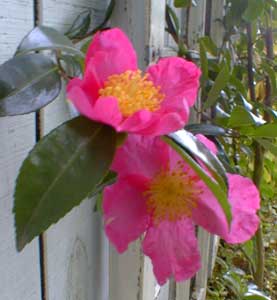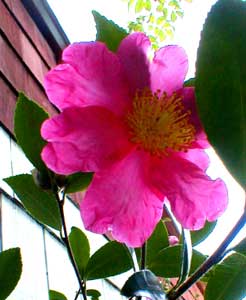
'Rosea'
Sazanka Camellia
"A camellia flower drops
And spills yesterday's rain."
-Yosa Bosun,
1717-1783
1717-1783
Camellia sasanqua is not nearly as common in the nursery trade as C. japonica which has vastly more cultivars.
The species is native of the Ryukyu Islands of Japan. In Tokugawa & Meiji Japan, an oil pressed from "Sazanka" seeds was used as aromatic lamp fuel by the wealthy. There was also a tradition of adding a single flower floating in a cup of green tea to sweeten the odor. Although the tea's taste was no less bitter, the beauty & scent of the flower provided release from sorrows.
Sazanka camellias seem not to have been cultivated for nearly as many centuries as is the case with C. japonica. It seems first to have been cultivated early in the Tokugawa period when a craze for flowering shrubs infected the merchant class. There were fierce regulations against accumulation of money, so wealth was often invested in gardens, & the long-grown C. japonica soon had other camellia species joining it.
The first hybridizer of record was the famed horticultural pioneer Ihei Ito (1695-1733) who was also the foremost azalea expert of his era. The first C. sasanqua introduced into western gardens were brought to England in 1879 by plant-hunter Charles Maries. Maries, funded by the nursery firm of Veitch & Veitch, had followed in the wake of John Gould Veitch (the first "longnosed barbarian" to make the sacred ascent of Mount Fuji), & both were soon joined by Charles Sprague Sargent of Boston's Arnold Arboretum.
These chums & botanical explorers were at the forefront of the west's Victorian fascination for the formerly isolationist nation, insuring many shrubs & trees that were commonly gardened in Japan would become just as essential to western gardening.
 The variety shown on this page was sold to us as 'Jean May,' but that old variety has semi-double flowers & a much lighter pink, whereas what actually bloomed were large deep rose-pink singles. I believe it is 'Rosea,' the standard single that closely resembles the rarely gardened wild species, but with richer color, larger flowers three to four inches across, with a furry heart of bright yellow stamins showing dramatically.
The variety shown on this page was sold to us as 'Jean May,' but that old variety has semi-double flowers & a much lighter pink, whereas what actually bloomed were large deep rose-pink singles. I believe it is 'Rosea,' the standard single that closely resembles the rarely gardened wild species, but with richer color, larger flowers three to four inches across, with a furry heart of bright yellow stamins showing dramatically.'Rosea' has proven to be long-flowering for us, with a few buds opening early in October, many by mid-October, remaining in full bloom throughout November & calming down by December. But it is outdone by our Camellia 'Showa-no-Sakae' which blossoms October well into January with a few lingering flowers as late as March.
The species can sometimes reach twenty feet, but cultivars are rarely so large. Ours was six or seven feet tall & spindly when planted; it now leans over our heads at eight feet or so, & has added considerable foliage density, though still very far from compactly leafed, being by nature a little spindly though not unattractively so.
The second portrait (at the left) shows a blossom eight feet in the air; it is transluscent because it was shot against a bright sky (in October 2003) by pointing the camera above my head. The second photo (above right) is also from October.
Although 'Rosea' can be free-standing & upright, or house-hugging either one, it is in general such a "floppy" evergreen that it is best to train it to an espalier. We've trained it onto this antique window frame so that it is climbing the wall in semi-shade, having plenty of reflected sunlight above, which it reaches for. Sazankas can tolerate considerable sunlight up to full sun so long as the root crown at least is shaded, but bright shade is best.
Since the base of our 'Rosea' is properly in shade, no mulching is necessary, certainly not in winter when it is best to keep any garden rubble away from the base of camellias that are otherwise susceptible to fungus. In summer, if the roots were apt to be sunned, careful light mulching could be done to protect the extensive but shallow root system from becoming overheated.
It needs moist, well-draining acid soil such as is typical of the coastal Pacific Northwest. Light, frequent fertilizing throughout growing season, or just a touch of evergreen fertilizer after it stops blooming in winter, will insure fullest bloom each year.